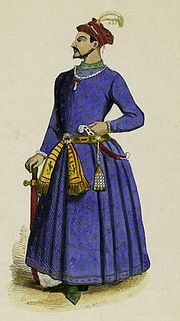
The commander of the Imperial Guard of Delhi
An imperial guard or palace guard is a special group of troops (or a member thereof) of an empire, typically closely associated directly with the Emperor or Empress. Usually these troops embody a more elite status than other imperial forces, including the regular armed forces, and maintain special rights, privileges and traditions.
Because the head of state often wishes to be protected by the best soldiers available, their numbers and organisation may be expanded to carry out additional tasks. Napoleon's Imperial Guard is an example of this. Some empires maintained guard units, such as the British Empire, which still exist. In the post-colonial period, the term has been used colloquially and derisively to describe the staff of a person, usually a politician or corporate executive officer, that acts to prevent direct communication with the person.
List of Imperial Guards[]
- Somatophylakes, bodyguards of Alexander the Great and the Macedonian Empires.
- Persian Immortals aka Immortal Guards:
- The Persian Immortals, existing in Persia under the Achaemenean dynasty
- Immortals (Byzantine), established under the Byzantine emperor Michael VII
- The Immortals, the Iranian Imperial Guard, existing in Persia and Iran in the 20th century under the Pahlavi dynasty
- The Immortals, Nihang warriors or Sikh Akalis who have played the pivotal role in Sikh military history
- Praetorian Guard of the Roman Empire, from around 27 B.C. until 312 A.D.
- Jovians and Herculians, elite Guards legions during the Tetrarchy
- Scholae Palatinae, late Roman Imperial Guards in both Western and Eastern Empires. Established in ca. 312, in the West until the 490s, in Byzantine service until ca. 1080.
- The Northern Army of the Han Dynasty was the standing professional army branch of the Han Empire, garrisoned around the capital. Several units from this army would be given the honor of guarding the emperor in the capitol.
- Spatharioi, Byzantine palace guards in the 5th-8th centuries
- Tagmata, elite Byzantine guard units (8th century-11th century)
- Hetaireia, Byzantine mercenary guard composed of men from Eastern Europe and Central Asia. (9th-12th centuries)
- The Great Mona'spa Guard was an elite sub branch of the Kingdom of Georgia royal guard, which itself was an elite formation of the Georgian king's army.
- Varangian Guard of the Byzantine Empire
- Janissaries of the Ottoman Empire
- Imperial Guards (Tang Dynasty), formed initially as honour bodyguards of the emperor and garrison of the capital, and evolved to reflect the era's transition of reliance on professional soldiery over non-professional volunteers and conscripts.
- Imperial Guards Brigade of Manchu Banner soldiers, entrusted with guarding the person of the Emperor of China and the Forbidden City during the Qing dynasty
- Imperial Guard of Manchukuo
- Imperial Guard of Napoleon I and the First French Empire
- Imperial Guard (Napoleon III) of the Second French Empire
- Russian Imperial Guard, also known as the Leib Guard, of the Russian Emperor
- Gardekorps of the German Empire
- Imperial Guard of Japan
- Esho of the Oyo Empire
- Kebur Zabangna (Ethiopian empire)
- Kheshig of the Mongol Empire
- The Household Division of the United Kingdom
Fiction[]
The term has been used in fiction:
- Imperial Guard, a group of alien warriors in the Marvel Comics universe that are charged with the duty of serving the Shi'ar Empire.
- Emperor's Royal Guard, Emperor Palpatine's personal protectors in the Star Wars universe.
- The Imperial Guard (Warhammer 40,000), the army of the Imperium in the Warhammer 40,000 tabletop miniature wargame.
- The Crimson Brigade, the Empire of Izmir's elite fighting unit in the 2000 film titled: "Dungeons & Dragons".
- The Sardaukar of the Padishah Emperor and the Fremen Fedaykin of Paul Muad'dib both serve as imperial guards in Frank Herbert's novel.
See also[]
| Wikimedia Commons has media related to Imperial guards. |
- List of empires
- List of largest empires
- List of extinct countries, empires, etc.
- Imperialism
- Colonialism
- Royal Guard
- Republican Guard (disambiguation)
- National Guard (disambiguation)
The original article can be found at Imperial Guard and the edit history here.